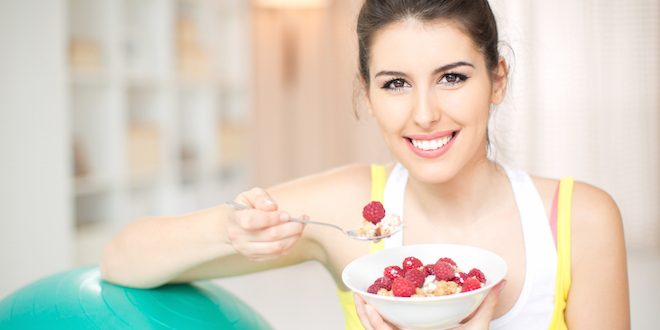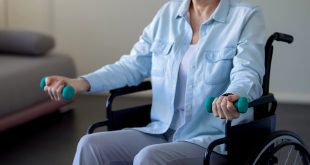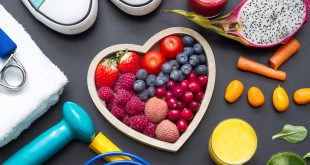While it’s true that exercise can give you more energy and strength during the day, you need to fuel your body properly for activity.
Two of the main players for sports nutrition are protein and carbohydrate. Your muscles rely on carbohydrate foods for energy, and protein foods for repairing, strengthening and building muscle. If you don’t eat enough carbohydrate, your body will need to use protein for energy. That may not sound so bad, but here’s what can happen:
- There may not be enough protein for muscle repair. Exercise leads to microscopic damage to your muscles and you need protein to keep muscles healthy. If your muscles do not repair well, you will be more susceptible to injury.
- Your muscles may not get stronger.
- You may feel tired during and after your workouts.
Although regular exercise is a vital component of a healthy lifestyle, it can increase oxidative stress and lead to inflammation. Vitamins and minerals play an important role in protecting the body against oxidative damage and inflammation. They are also important for the production of energy and for assisting with building and repair of muscles during recovery from exercise and injury.
Whether you’re doing a casual workout or training for a competition, eating well will help you get the most out of your activity. Here are some strategies that will help you feel your best when you exercise. Be sure to speak with your doctor or diabetes educator if you are taking medication that may cause low blood glucose levels. You may need some additional dietary strategies to help prevent low blood sugar resulting from exercise.
Start cooking! Your diet can contribute to inflammation. Try to avoid or limit these foods as much as possible:
- Refined carbohydrates, such as baked sweet goods and white bread
- Packaged and highly processed foods that contain added sugar, salt and fat
- French fries and other fried foods
- Regular pop and other sugar-sweetened beverages
- Red meat (burgers, steaks) and processed meat (hot dogs, sausage)
- Hard margarine, shortening and lard
Eat three balanced meals each day. Following the plate method of meal planning can help ensure that you eat the right amount of protein and carbohydrate, as well as lots of vitamins and minerals.
Your diet can help fight against inflammation. To help offset inflammation that may arise from exercise, eat a balanced diet that is rich in natural antioxidants and phytochemicals. Choose whole grains, legumes and beans, sprouts and seeds, and a wide variety of fruits and veggies.
When size matters. After you eat, your body wants to focus on digesting your food. While you exercise, your body wants to focus on your muscles. If you exercise immediately after eating, these competing demands will make it challenging to have a good workout. As well, eating too close to a workout may cause you to experience some gastrointestinal discomfort. Although different people tolerate different things, generally, the closer you get to a workout the more simple your meal should be. If you eat two to three hours beforehand, you’ll have time for your food to digest and be absorbed from your gastrointestinal tract into your blood. Therefore, you can eat a more complex meal that contains protein, carbs, fat and fiber, which take longer to break down. If you eat within an hour of a workout, however, you should eat something that will be digested and absorbed more quickly, such as a small bowl of cereal or some fruit. Experiment and see what works best for your body.
Eat after you exercise. If it is meal time, then eat a balanced meal. If you won’t have a meal for several hours, have a snack. To help your muscles recover and to replace their energy stores, eat something that contains both protein and carbohydrate within two hours of your exercise session. Aim for 20 grams of protein. Dairy proteins seem to be better than other proteins, because they are digested and absorbed quickly; as well, they have a high leucine content, an amino acid that plays an important role in speeding up muscle recovery.
Good post-workout snack choices include:
- Greek yogurt and fruit
- Half a sandwich, made with peanut butter and banana, and a glass of milk
- A smoothie made with low-fat milk or kefir, and fruit
- Eggs and whole grain toast
Drink up! Staying hydrated has a huge impact on overall health. To function properly, all the cells and organs of the body need water. Water is used to lubricate joints, protect the spinal cord and other sensitive tissues, regulate body temperature, transport nutrients and eliminate waste products. Despite how crucial water is, a significant number of people fail to consume the recommended levels of fluids each day. According to Dietitians of Canada, an adequate intake for men is approximately 13 cups (3 liters) a day. For women, an adequate intake is around 9 cups (2.2 liters) a day. This amount of fluid is likely sufficient if you are doing light activity that does not cause you to sweat. But if you are working up a sweat, then you will need additional fluids. Click here for more information.
To meet your daily fluid needs, remember to drink throughout the day. Choose water most of the time, but other fluids, such as milk, tea and coffee, can also contribute to your fluid intake. Alcoholic beverages do not count as fluid. If you aren’t a fan of plain water, add flavour with slices of orange, lemon, lime or cucumber.
Whatever activity you undertake, be sure to fuel yourself with healthy foods and plenty of fluids. Your body will thank you for it!
 Diabetes Care Community Learn, connect and care
Diabetes Care Community Learn, connect and care



